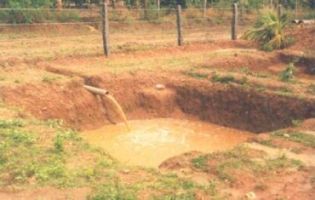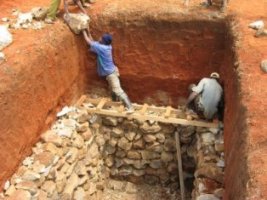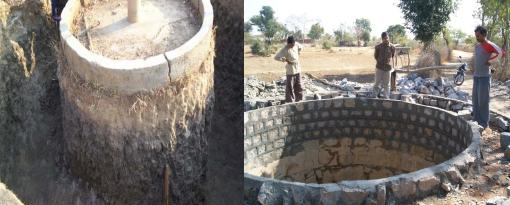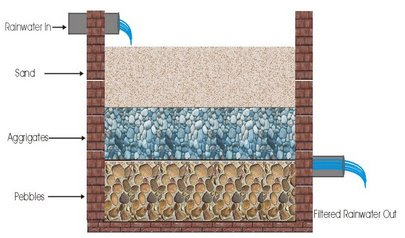Roof and Terrain Water Harvesting System
RAIN WATER HARVESTING AND ARTIFICIAL RECHARGE TO GROUND WATER
WHAT IS RAIN WATER HARVESTING?
The principle of collecting and using precipitation from a catchments surface. An old technology is gaining popularity in a new way. Rain water harvesting is enjoying a renaissance of sorts in the world, but it traces its history to biblical times. Extensive rain water harvesting apparatus existed 4000 years ago in the Palestine and Greece. In ancient Rome, residences were built with individual cisterns and paved courtyards to capture rain water to augment water from city's aqueducts. As early as the third millennium BC, farming communities in Baluchistan and Kutch impounded rain water and used it for irrigation dams.
ARTIFICAL RECHARGE TO GROUND WATER :
Artificial recharge to ground water is a process by which the ground water reservoir is augmented at a rate exceeding that obtaining under natural conditions or replenishment. Any man-made scheme or facility that adds water to an aquifer may be considered to be an artificial recharge system.
WHY RAIN WATER HARVESTING :
Rain water harvesting is essential because :-
Surface water is inadequate to meet our demand and we have to depend on ground water.
Due to rapid urbanization, infiltration of rain water into the sub-soil has decreased drastically and recharging of ground water has diminished.
As you read this guide, seriously consider conserving water by harvesting and managing this natural resource by artificially recharging the system. The examples covering several dozen installations successfully operating in India constructed and maintained by CGWB, provide an excellent snapshot of current systems.
RAIN WATER HARVESTING TECHNIQUES :
There are two main techniques of rain water harvestings.
Storage of rainwater on surface for future use.
Recharge to ground water.
The storage of rain water on surface is a traditional techniques and structures used were underground tanks, ponds, check dams, weirs etc. Recharge to ground water is a new concept of rain water harvesting and the structures generally used are :-
Pits :- Recharge pits are constructed for recharging the shallow aquifer. These are constructed 1 to 2 m, wide and to 3 m. deep which are back filled with boulders, gravels, coarse sand.
 
Picture Source: hubpages.com/hub/rainwaterharvesting & cpar-tanzania.blogspot.com/2008/07/latest-scoop
Trenches:- These are constructed when the permeable stram is available at shallow depth. Trench may be 0.5 to 1 m. wide, 1 to 1.5m. deep and 10 to 20 m. long depending up availability of water. These are back filled with filter. materials.

Dug wells:- Existing dug wells may be utilised as recharge structure and water should pass through filter media before putting into dug well.

Picture Source: www.indg.in/rural-energy/view?set_language=te
Hand pumps :- The existing hand pumps may be used for recharging the shallow/deep aquifers, if the availability of water is limited. Water should pass through filter media before diverting it into hand pumps

Recharge wells :- Recharge wells of 100 to 300 mm. diameter are generally constructed for recharging the deeper aquifers and water is passed through filter media to avoid choking of recharge wells.
Recharge Shafts :- For recharging the shallow aquifer which are located below clayey surface, recharge shafts of 0.5 to 3 m. diameter and 10 to 15 m. deep are constructed and back filled with boulders, gravels & coarse sand.
Lateral shafts with bore wells :- For recharging the upper as well as deeper aquifers lateral shafts of 1.5 to 2 m. wide & 10 to 30 m. long depending upon availability of water with one or two bore wells are constructed. The lateral shafts is back filled with boulders, gravels & coarse sand.
Spreading techniques:- When permeable strata starts from top then this technique is used. Spread the water in streams/Nalas by making check dams, nala bunds, cement plugs, gabion structures or a percolation pond may be constructed.
DIVERSION OF RUN OFF INTO EXISTING SURFACE WATER BODIES
Construction activity in and around the city is resulting in the drying up of water bodies and reclamation of these tanks for conversion into plots for houses.
Free flow of storm run off into these tanks and water bodies must be ensured. The storm run off may be diverted into the nearest tanks or depression, which will create additional recharge.
Urbanisation effects on Groundwater Hydrology :
Increase in water demand
More dependence on ground water use
Over exploitation of ground water
Increase in run-off, decline in well yields and fall in water levels
Reduction in open soil surface area
Reduction in infiltration and deterioration in water quality
Methods of artificial recharge in urban areas :
Water spreading
Recharge through pits, trenches, wells, shafts
Rooftop collection of rainwater
Roadtop collection of rainwater
Induced recharge from surface water bodies.
Computation of artificial recharge from Roof top rainwater collection :
Factors taken for computation :
Roof top area 100 sq.m. for individual house and 500 sq.m. for multi-storied building.
Average annual monsoon rainfall - 780 mm.
Effective annual rainfall contributing to recharge 70% - 550 mm.
| |
Individual
Houses |
Multistoried
building |
Roof top area |
100 sq. m. |
500 sq. m. |
Total quantity available forrecharge per annum |
55 cu. m |
275 cu. m. |
Water available for 5 member Family |
100 days |
500 days |
Benefits of Artificial Recharge in Urban Areas :
-
Improvement in infiltration and reduction in run-off.
- Improvement in groundwater levels and yields.
- Reduces strain on Special Village Panchayats/ Municipal / Municipal Corporation water supply
- Improvement in groundwater quality
- Estimated quantity of additional recharge from 100 sq. m. roof top area is 55.000 liters.
Source: http://www.tn.gov.in/dtp/rainwater.htm
In Cities : If you live in a single dwelling house or a multi-tenant apartment complex, you already have 80% of the RWH system. We just need re-orient the plumbing design.The present design of the house will take all the rainwater from the roof and all the ground level areas surrounding the house and flow the water towards the street. (where it floods the street,clogs the storm drains and sewer lines for a few days, before flowingaway as sewage water) .From the roof tops, bring the rainwter down using closed PVC pipes and direct it to a sump. Include a simple 3-part filteration unit consisting of sand, brick jelly and broken mud bricksIf you do not have sump, use a well. In many parts of the country, old wells when they go dry, is used as garbage dumps. Please clean the well and put the rain water into it.

If you do not have a well, construct a baby well (about 2ft in diameter and about 16 feet deep based on soil structure)
Source: http://watercommunity.blogspot.com/2008/09/how-to-save-rain-water.html
HARVESTING RAINWATER HARNESSING LIFE :
A NOBLE GOAL - A COMMON RESPONSIBILITY
Ground water exploitation is inevitable is Urban areas. But the groundwater potential is getting reduced due to urbanisation resulting in over exploitation. Hence, a strategy to implement the groundwater recharge, in a major way need to be launched with concerted efforts by various Governmental and Non-Governmental Agencies and Public at large to build up the water table and make the groundwater resource, a reliable and sustainable source for supplementing water supply needs of the urban dwellers.
Recharge of groundwater through storm run off and roof top water collection, diversion and collection of run off into dry tanks, play grounds, parks and other vacant places are to be implemented by Special Village Panchayats/ Municipalities /Municipal Corporations and other Government Establishments with special efforts.
The Special Village Panchayats /Municipalities/Municipal Corporations will help the citizens and builders to adopt suitable recharge method in one's own house or building through demonstration and offering subsidies for materials and incentives, if possible.
ATTRIBUTES OF GROUNDWATER :
- There is more ground water than surface water
- Ground water is less expensive and economic resource.
- Ground water is sustainable and reliable source of water supply.
- Ground water is relatively less vulnerable to pollution
- Ground water is usually of high bacteriological purity.
- Ground water is free of pathogenic organisms.
- Ground water needs little treatment before use.
- Ground water has no turbidity and colour.
- Ground water has distinct health advantage as art alternative for lower sanitary quality surface water.
- Ground water is usually universally available.
- Ground water resource can be instantly developed and used.
- There is no conveyance losses in ground water based supplies.
- Ground water has low vulnerability to drought.
- Ground water is key to life in arid and semi-arid regions.
- Ground water is source of dry weather flow in rivers and streams.
Source: http://www.tn.gov.in/dtp/rainwater.htm
Picture sources:
http://sikandar78.files.wordpress.com/2009/11/rwh2.jpg
http://sikandar78.files.wordpress.com/2009/11/bore-well-recahrge-3.jpg |





